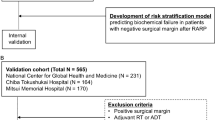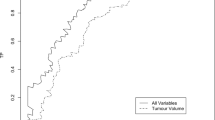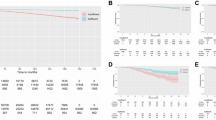Abstract
Background
Early biochemical recurrence (eBCR) after radical prostatectomy (RP) heralds poor oncological outcomes and may be prevented with adjuvant radiation (aRT).
Methods
We developed a contemporary eBCR nomogram in 13 797 RP patients from Hamburg (2005–2016) and externally validated it in 5952 RP patients from Vienna. Receiver operating characteristics-derived area under the curve (AUC), Heagerty’s C-index, and decision curve analysis (DCA) were used to quantify model accuracy and to compare the current tool with the Walz nomogram, the online Memorial Sloan Kettering Cancer Center (MSKCC) nomogram and the post-surgical Cancer of the Prostate Risk Assesment (CAPRA-S).
Results
The eBCR nomogram relies on independent BCR predictors at 12 and 24 months after RP: preoperative PSA, pathological Gleason Score, tumor stage, lymph node, and surgical margin status. It achieved 81% accuracy at both time points in external validation. Additionally, the current nomogram yielded best calibration, optimal DCA results, and highest rates of avoided aRT in cutoff analyses, compared to the Walz nomogram, the MSKCC nomogram, and the CAPRA-S score.
Conclusions
The updated eBCR nomogram is easily applicable, highly accurate, and may allow avoiding immediate aRT in a large proportion of patients with few concomitant missed eBCR instances. It compares favorably to similar tools.
This is a preview of subscription content, access via your institution
Access options
Subscribe to this journal
Receive 4 print issues and online access
$259.00 per year
only $64.75 per issue
Buy this article
- Purchase on Springer Link
- Instant access to full article PDF
Prices may be subject to local taxes which are calculated during checkout



Similar content being viewed by others
References
Han M, Partin AW, Zahurak M, Piantadosi S, Epstein JI, Walsh PC. Biochemical (prostate specific antigen) recurrence probability following radical prostatectomy for clinically localized prostate cancer. J Urol. 2003;169:517–23.
Simmons MN, Stephenson AJ, Klein EA. Natural history of biochemical recurrence after radical prostatectomy: risk assessment for secondary therapy. Eur Urol. 2007;51:1175–84.
Dillioglugil O, Leibman BD, Kattan MW, Seale-Hawkins C, Wheeler TM, SP T. Hazard rates for progression after radical prostatectomy for clinically localized prostate cancer. Urology. 1997;50:93–9.
Shariat SF, Karakiewicz PI, Roehrborn CG, Kattan MW. An updated catalog of prostate cancer predictive tools. Cancer. 2008;113:3075–99.
Kattan MW, Wheeler TM, Scardino PT. Postoperative nomogram for disease recurrence after radical prostatectomy for prostate cancer. J Clin Oncol. 1999;17:1499–507.
Roberts WW, Bergstralh EJ, Blute ML, Slezak JM, Carducci M, Han M, et al. Contemporary identification of patients at high risk of early prostate cancer recurrence after radical retropubic prostatectomy. Urology. 2001;57:1033–7.
Cooperberg MR, Hilton JF, Carroll PR. The CAPRA-S score: a straightforward tool for improved prediction of outcomes after radical prostatectomy. Cancer. 2011;117:5039–46.
Mottet N, Bellmunt J, Bolla M, Briers E, Cumberbatch MG, De Santis M, et al. EAU-ESTRO-SIOG guidelines on prostate cancer. Part 1: screening, diagnosis, and local treatment with curative intent. Eur Urol. 2017;71:618–29.
Mohler JM, Antonarakis ES, Armstrong AJ. NCCN Clinical Practice Guidelines in Oncology (NCCN Guidelines®) ProstateCancer Version 2.2017—21 February 2017. https://www.nccn.org/professionals/physician_gls/pdf/prostate.pdf; last checked: 31st August 2017.
Walz J, Chun FK, Klein EA, Reuther A, Saad F, Graefen M. et al. Nomogram predicting the probability of early recurrence after radical prostatectomy for prostate cancer. J Urol. 2009;181:601–7.
Mir MC, Li J, Klink JC, Kattan MW, Klein EA, Stephenson AJ. Optimal definition of biochemical recurrence after radical prostatectomy depends on pathologic risk factors: identifying candidates for early salvage therapy. Eur Urol. 2014;66:204–10.
Kaplan EL, Meier P. Nonparametrici estimation from incomplete observations. J Am Stat Assoc. 1958;53:457–81.
Heagerty PJ, Lumley T, Pepe MS. Time-dependent ROC curves for censored survival data and a diagnostic marker. Biometrics. 2000;56:337–44.
Vickers AJ, Elkin EB. Decision curve analysis: a novel method for evaluating prediction models. Med Decis Mak. 2006;26:565–74.
MSKC Center. https://www.mskcc.org/nomograms/prostate; last checked: 31st August 2017.
Jhaveri FM, Zippe CD, Klein EA, Kupelian PA. Biochemical failure does not predict overall survival after radical prostatectomy for localized prostate cancer: 10-year results. Urology. 1999;54:884–90.
Ho R, Siddiqui MM, George AK, Frye T, Kilchevsky A, Fascelli M, et al. Preoperative multiparametric magnetic resonance imaging predicts biochemical recurrence in prostate cancer after radical prostatectomy. PLoS ONE. 2016;11:e0157313.
Murray NP, Aedo S, Reyes E, Orellana N, Fuentealba C, Jacob O. Prediction model for early biochemical recurrence after radical prostatectomy based on the Cancer of the Prostate Risk Assessment score and the presence of secondary circulating prostate cells. BJU Int. 2016;118:556–62.
Murray NP, Reyes E, Orellana N, Fuentealba C, Jacob O. Comparison of the Walz nomogram and presence of secondary circulating prostate cells for predicting early biochemical failure after radical prostatectomy for prostate cancer in chilean men. Asian Pac J Cancer Prev. 2015;16:7123–7.
Barkati M, Simard D, Taussky D, Delouya G. Magnetic resonance imaging for prostate bed radiotherapy planning: an inter- and intra-observer variability study. J Med Imaging Radiat Oncol. 2016;60:255–9.
Bolla M, van Poppel H, Tombal B, Vekemans K, Da Pozzo L, de Reijke TM, et al. Postoperative radiotherapy after radical prostatectomy for high-risk prostate cancer: long-term results of a randomised controlled trial (EORTC trial 22911). Lancet. 2012;380:2018–27.
Wiegel T, Bottke D, Steiner U, Siegmann A, Golz R, Storkel S, et al. Phase III postoperative adjuvant radiotherapy after radical prostatectomy compared with radical prostatectomy alone in pT3 prostate cancer with postoperative undetectable prostate-specific antigen: ARO 96-02/AUO AP 09/95. J Clin Oncol. 2009;27:2924–30.
Wiegel T, Lohm G, Bottke D, Hocht S, Miller K, Siegmann A, et al. Achieving an undetectable PSA after radiotherapy for biochemical progression after radical prostatectomy is an independent predictor of biochemical outcome—results of a retrospective study. Int J Radiat Oncol Biol Phys. 2009;73:1009–16.
Stephenson AJ, Scardino PT, Kattan MW, Pisansky TM, Slawin KM, Klein EA, et al. Predicting the outcome of salvage radiation therapy for recurrent prostate cancer after radical prostatectomy. J Clin Oncol. 2007;25:2035–41.
Cho YM, Jung SJ, Cho N, Kim MJ, Kattan MW, Yu C, et al. Impact of international variation of prostate cancer on a predictive nomogram for biochemical recurrence in clinically localised prostate cancer. World J Urol. 2014;32:399–405.
Gallina A, Chun FK, Suardi N, Eastham JA, Perrotte P, Graefen M, et al. Comparison of stage migration patterns between Europe and the USA: an analysis of 11 350 men treated with radical prostatectomy for prostate cancer. BJU Int. 2008;101:1513–8.
Stephenson JA, Scardino PT, Eastham JA, Bianco FJ Jr, Dotan ZA, DiBlasio CJ, et al. Postoperative nomogram predicting the 10-year probability of prostate cancer recurrence after radical prostatectomy. J Clin Oncol. 2005;23:7005–12.
Acknowledgements
This research received no specific grant from any funding agency in the public, commercial, or not-for-profit sectors.
Author information
Authors and Affiliations
Corresponding author
Ethics declarations
Conflict of interest
The authors declare that they have no conflict of interest.
Rights and permissions
About this article
Cite this article
Pompe, R.S., Bandini, M., Preisser, F. et al. Contemporary approach to predict early biochemical recurrence after radical prostatectomy: update of the Walz nomogram. Prostate Cancer Prostatic Dis 21, 386–393 (2018). https://doi.org/10.1038/s41391-018-0033-1
Received:
Revised:
Accepted:
Published:
Issue Date:
DOI: https://doi.org/10.1038/s41391-018-0033-1



